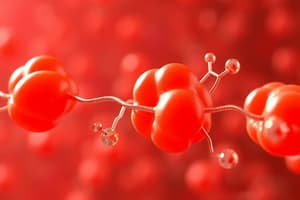Podcast
Questions and Answers
What role does malate dehydrogenase play in the biosynthesis of fatty acids?
What role does malate dehydrogenase play in the biosynthesis of fatty acids?
- It converts pyruvate to oxaloacetate.
- It catalyzes the esterification of fatty acids.
- It produces NADPH from malate.
- It converts oxaloacetate to malate. (correct)
How is triacylglycerol formed?
How is triacylglycerol formed?
- From the conversion of glucose to glycerol.
- By the conversion of pyruvate to fatty acids.
- By the reaction of NADPH with malate.
- Through the esterification of fatty acids with glycerol-3 phosphate. (correct)
What is the primary source of NADPH in fatty acid synthesis?
What is the primary source of NADPH in fatty acid synthesis?
- Conversion of fatty acids into TAG.
- Lipolysis of depot fat.
- Malic enzyme and the pentose phosphate pathway. (correct)
- Insulin stimulation of glycolysis.
What is the primary effect of insulin on lipogenesis?
What is the primary effect of insulin on lipogenesis?
What happens to the TAG formed in the liver?
What happens to the TAG formed in the liver?
What is the primary function of chylomicrons?
What is the primary function of chylomicrons?
Which apolipoprotein is associated with the receptor binding of VLDL?
Which apolipoprotein is associated with the receptor binding of VLDL?
What happens to VLDL as it loses triglycerides in the bloodstream?
What happens to VLDL as it loses triglycerides in the bloodstream?
Which of the following lipoproteins carries approximately 50% of blood cholesterol?
Which of the following lipoproteins carries approximately 50% of blood cholesterol?
Hyperlipoproteinemia is characterized by what?
Hyperlipoproteinemia is characterized by what?
What is a characteristic feature of Hyperlipidemia Type II?
What is a characteristic feature of Hyperlipidemia Type II?
What is the role of apo E in lipoprotein metabolism?
What is the role of apo E in lipoprotein metabolism?
Which type of hyperlipidemia is characterized by both hypercholesterolemia and hypertriacylglycerodemia?
Which type of hyperlipidemia is characterized by both hypercholesterolemia and hypertriacylglycerodemia?
What characterizes Type V hyperlipoproteinemia?
What characterizes Type V hyperlipoproteinemia?
Which process is primarily responsible for lipogenesis in mammals?
Which process is primarily responsible for lipogenesis in mammals?
What is the main stored form of energy in adipose cells?
What is the main stored form of energy in adipose cells?
What role does glycerol-3 phosphate dehydrogenase play in lipid metabolism?
What role does glycerol-3 phosphate dehydrogenase play in lipid metabolism?
Which of the following is a requirement for the de novo synthesis of fatty acids?
Which of the following is a requirement for the de novo synthesis of fatty acids?
In which organ is glycerokinase present, allowing glycerol phosphate formation from glucose?
In which organ is glycerokinase present, allowing glycerol phosphate formation from glucose?
Which cofactor is NOT required for lipogenesis?
Which cofactor is NOT required for lipogenesis?
What effect does uncontrolled diabetes have on lipid metabolism?
What effect does uncontrolled diabetes have on lipid metabolism?
What is the primary function of apolipoproteins?
What is the primary function of apolipoproteins?
Which lipoprotein is primarily responsible for transporting dietary lipids from the intestine to tissues?
Which lipoprotein is primarily responsible for transporting dietary lipids from the intestine to tissues?
Which of the following lipoproteins carries cholesterol esters as its major lipid component?
Which of the following lipoproteins carries cholesterol esters as its major lipid component?
Apo-A1 is a major apolipoprotein for which type of lipoprotein?
Apo-A1 is a major apolipoprotein for which type of lipoprotein?
Which of the following statements about lipoproteins is true?
Which of the following statements about lipoproteins is true?
What is the ligand for LDL receptors?
What is the ligand for LDL receptors?
Which lipoprotein is involved in transferring endogenous lipids from the liver to peripheral tissues?
Which lipoprotein is involved in transferring endogenous lipids from the liver to peripheral tissues?
Which apolipoprotein activates lipoprotein lipase?
Which apolipoprotein activates lipoprotein lipase?
What is formed from the condensation of acetyl-CoA and oxaloacetate for transport out of mitochondria?
What is formed from the condensation of acetyl-CoA and oxaloacetate for transport out of mitochondria?
Which enzyme is responsible for converting acetyl-CoA to malonyl-CoA in fatty acid synthesis?
Which enzyme is responsible for converting acetyl-CoA to malonyl-CoA in fatty acid synthesis?
What is the final product of fatty acid synthesis as mentioned in the process?
What is the final product of fatty acid synthesis as mentioned in the process?
How many molecules of NADPH are consumed in the overall reaction of fatty acid synthesis?
How many molecules of NADPH are consumed in the overall reaction of fatty acid synthesis?
Which step involves the repetition of four distinct reactions leading to fatty acid elongation?
Which step involves the repetition of four distinct reactions leading to fatty acid elongation?
What is the primary role of ATP in the fatty acid synthesis process?
What is the primary role of ATP in the fatty acid synthesis process?
What molecule is NOT produced during the synthesis of palmitate?
What molecule is NOT produced during the synthesis of palmitate?
Which of the following statements about acetyl-CoA is true?
Which of the following statements about acetyl-CoA is true?
Flashcards
What are lipoproteins?
What are lipoproteins?
They are non-covalent assemblies of lipids and proteins, crucial for transporting lipids in the bloodstream.
Describe the structure of a lipoprotein.
Describe the structure of a lipoprotein.
The core of a lipoprotein particle contains mainly triglycerides and cholesterol esters, while the surface is composed of phospholipids, proteins (apolipoproteins), and cholesterol.
Name the four major groups of plasma lipoproteins.
Name the four major groups of plasma lipoproteins.
Chylomicrons, very low-density lipoproteins (VLDL), low-density lipoproteins (LDL), and high-density lipoproteins (HDL) are the four major groups, each with a distinct structure and function.
What is the function of chylomicrons?
What is the function of chylomicrons?
Signup and view all the flashcards
What is the function of VLDL?
What is the function of VLDL?
Signup and view all the flashcards
What is the function of LDL?
What is the function of LDL?
Signup and view all the flashcards
What is the function of HDL?
What is the function of HDL?
Signup and view all the flashcards
What are apolipoproteins and what do they do?
What are apolipoproteins and what do they do?
Signup and view all the flashcards
Chylomicron
Chylomicron
Signup and view all the flashcards
Very Low-Density Lipoprotein (VLDL)
Very Low-Density Lipoprotein (VLDL)
Signup and view all the flashcards
Low-Density Lipoprotein (LDL)
Low-Density Lipoprotein (LDL)
Signup and view all the flashcards
Hyperlipoproteinemia
Hyperlipoproteinemia
Signup and view all the flashcards
Hyperlipidemia Type I
Hyperlipidemia Type I
Signup and view all the flashcards
Hyperlipidemia Type II
Hyperlipidemia Type II
Signup and view all the flashcards
Hyperlipidemia Type III
Hyperlipidemia Type III
Signup and view all the flashcards
Hyperlipidemia Type VI
Hyperlipidemia Type VI
Signup and view all the flashcards
Lipogenesis
Lipogenesis
Signup and view all the flashcards
GP acyl transferase
GP acyl transferase
Signup and view all the flashcards
Fatty Acid Synthesis
Fatty Acid Synthesis
Signup and view all the flashcards
Insulin
Insulin
Signup and view all the flashcards
Triacylglycerol (TAG)
Triacylglycerol (TAG)
Signup and view all the flashcards
Type V Hyperlipoproteinemia
Type V Hyperlipoproteinemia
Signup and view all the flashcards
Where does Lipogenesis occur?
Where does Lipogenesis occur?
Signup and view all the flashcards
How is glycerol-3-phosphate produced?
How is glycerol-3-phosphate produced?
Signup and view all the flashcards
What is the difference in glycerol-3-phosphate production in liver and adipose tissue?
What is the difference in glycerol-3-phosphate production in liver and adipose tissue?
Signup and view all the flashcards
Where does fatty acid synthesis (lipogenesis) take place?
Where does fatty acid synthesis (lipogenesis) take place?
Signup and view all the flashcards
What co-factors are required for lipogenesis?
What co-factors are required for lipogenesis?
Signup and view all the flashcards
How are unsaturated fatty acids synthesized?
How are unsaturated fatty acids synthesized?
Signup and view all the flashcards
Acetyl-CoA
Acetyl-CoA
Signup and view all the flashcards
Malonyl CoA
Malonyl CoA
Signup and view all the flashcards
Acetyl-CoA Carboxylase
Acetyl-CoA Carboxylase
Signup and view all the flashcards
Fatty Acid Synthase
Fatty Acid Synthase
Signup and view all the flashcards
Palmitic Acid
Palmitic Acid
Signup and view all the flashcards
Condensation Reaction
Condensation Reaction
Signup and view all the flashcards
Energy Input
Energy Input
Signup and view all the flashcards
Fatty Acid Activation
Fatty Acid Activation
Signup and view all the flashcards
Study Notes
Medical Biochemistry - Lipid Metabolism
- This course covers lipid transport, biosynthesis, and associated disorders, specifically for first-year MBBS and Dentistry students at Umm Al-qura University.
Lipid Transport
- Lipids in blood plasma, including fats, phospholipids, cholesterol, cholesterol esters, and fatty acids, are transported as lipoproteins.
- Lipoproteins are non-covalent assemblies of lipids and proteins.
- Key lipoprotein types include chylomicrons, VLDL, LDL, and HDL, each with unique structural components (core and surface) and functions in transporting triglycerides and cholesterol throughout the body.
Lipoprotein Composition
- Key proteins (apoproteins): Apo B-48, Apo B-100, and Apo A-I.
- Key lipids (lipoproteins) include TG, TG, CE, CE.
- Different lipoproteins have varying percentages of protein and lipid content.
Lipoprotein Disorders
- Hyperlipoproteinemia (hyperlipidemia): A group of disorders characterized by elevated plasma lipoprotein levels.
- Hyperlipidemia is classified into five types (Type I to Type V), each with a specific cause and manifestation.
- Type I: Deficiency in lipoprotein lipase enzyme resulting in increased plasma chylomicrons and turbid plasma.
- Type II: Reduced LDL metabolism due to LDL receptor defects, leading to high plasma cholesterol levels (familial hypercholesterolemia).
- Type III: Defective Apo E, affecting uptake and metabolism of VLDL and chylomicron remnants, resulting in both high cholesterol and high triglycerides.
- Type IV: Increased formation of triglycerides from carbohydrates, leading to high VLDL and triglycerides levels, and turbid plasma.
- Type V: Associated with obesity and glucose intolerance, featuring high chylomicrons, high VLDL, and high triglycerides, and turbid plasma.
Fatty Liver
- Fatty liver is a metabolic disorder where triglycerides accumulate in the liver.
- This can occur during fasting, high-fat diets, or uncontrolled diabetes.
Lipid Biosynthesis
- This section focuses on the synthesis of lipids, specifically fatty acids.
- It details the biosynthesis process, highlighting the key regulatory enzymes and steps.
Fatty Acid Synthesis (Lipogenesis)
- Lipogenesis primarily occurs in the liver and adipose tissues, but also in other organs like brain and kidneys.
- It utilizes acetyl-CoA as the key substrate and requires cofactors such as NADPH, ATP, Mn2+, biotin, and HCO3-.
- Fatty acid synthesis is a separate metabolic pathway distinct from fatty acid breakdown.
- A crucial step involves the formation of citrate from acetyl-CoA within the mitochondria, followed by citrate translocation to the cytoplasm. The citric acid cycle plays a part of acetyl-CoA conversion into fatty acids.
Synthesis of Glycerol-3P
- Glucose is oxidized via glycolysis to dihydroxyacetone phosphate.
- This is reduced to glycerol-3 phosphate by the enzyme glycerol-3 phosphate dehydrogenase, making glycerol-3-P the precursor for membrane lipids and triglycerides.
Regulation of Lipogenesis
- Insulin promotes lipogenesis, while glucagon and epinephrine inhibit it.
- Insulin affects short-term regulation of acetyl CoA carboxylase (a regulatory enzyme in fatty acid synthesis).
- Long-term regulation may also be affected by diet, such as high/low carbohydrate intake.
Fates of Formed TAG
- Formed TAG (triacylglycerol) is transported differently after its formation.
- In the liver, TAG is initially converted into VLDL for transport to tissues.
- In adipose tissue, TAG is stored as fat.
Studying That Suits You
Use AI to generate personalized quizzes and flashcards to suit your learning preferences.




